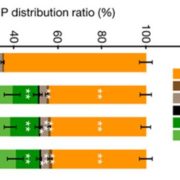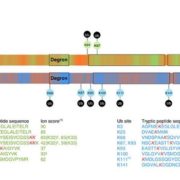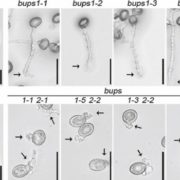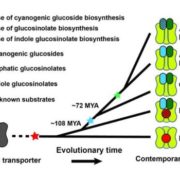RNA Mobility and the Regulation of Flowering
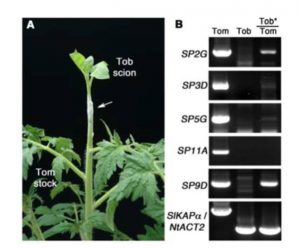 In addition to hormones, proteins, and metabolites, many plants use mRNAs as mobile molecules for long-distance communication. It has been demonstrated that many mobile mRNAs are trafficked through phloem, probably by forming an RNA-protein complex to allow the stable translocation of mRNA molecules. Transcriptome profiling of phloem sap and heterografting experiments have identified several thousand mobile mRNAs. Photoperiodic floral regulation is mediated by two counteracting mobile molecules, namely florigen and antiflorigen, which are encoded by a pair of functionally opposite homologues belonging to different clades in the phosphatidylethanolamine binding-domain protein (PEBP) gene family. In Arabidopsis, florigen and antiflorigen are encoded by FLOWERING LOCUS T (FT) and ARABIDOPSIS THALIANA CENTRORADIALIS homolog (ATC), respectively. The expression of FT or ATC is induced under long-day or short-day conditions, respectively. FT and ATC both regulate the expression of the same downstream meristem identity gene, APETALA1. Previous studies have established that the long-distance movement of PEBP family proteins is an evolutionarily conserved mechanism in many plants; however, the possible movement of PEBP family mRNAs remains controversial. Huang et al. (10.1104/pp.18.00725) have examined the mRNA movement of PEBP genes in different plant species. They have identified a tobacco (Nicotiana sylvestris) CENTRORADIALIS-like 1 gene, denoted NsCET1, and show that it is an ortholog of Arabidopsis antiflorigen ATC. In tobacco, NsCET1 acts as a mobile molecule that inhibits flowering. Grafting experiments revealed that endogenous and ectopically expressed NsCET1 mRNAs move long distances in tobacco and Arabidopsis. Heterografts of tobacco and tomato (Lycopersicon esculentum) show that mRNA mobility is a common feature of the three clades of PEBP-like genes among different plant species.
In addition to hormones, proteins, and metabolites, many plants use mRNAs as mobile molecules for long-distance communication. It has been demonstrated that many mobile mRNAs are trafficked through phloem, probably by forming an RNA-protein complex to allow the stable translocation of mRNA molecules. Transcriptome profiling of phloem sap and heterografting experiments have identified several thousand mobile mRNAs. Photoperiodic floral regulation is mediated by two counteracting mobile molecules, namely florigen and antiflorigen, which are encoded by a pair of functionally opposite homologues belonging to different clades in the phosphatidylethanolamine binding-domain protein (PEBP) gene family. In Arabidopsis, florigen and antiflorigen are encoded by FLOWERING LOCUS T (FT) and ARABIDOPSIS THALIANA CENTRORADIALIS homolog (ATC), respectively. The expression of FT or ATC is induced under long-day or short-day conditions, respectively. FT and ATC both regulate the expression of the same downstream meristem identity gene, APETALA1. Previous studies have established that the long-distance movement of PEBP family proteins is an evolutionarily conserved mechanism in many plants; however, the possible movement of PEBP family mRNAs remains controversial. Huang et al. (10.1104/pp.18.00725) have examined the mRNA movement of PEBP genes in different plant species. They have identified a tobacco (Nicotiana sylvestris) CENTRORADIALIS-like 1 gene, denoted NsCET1, and show that it is an ortholog of Arabidopsis antiflorigen ATC. In tobacco, NsCET1 acts as a mobile molecule that inhibits flowering. Grafting experiments revealed that endogenous and ectopically expressed NsCET1 mRNAs move long distances in tobacco and Arabidopsis. Heterografts of tobacco and tomato (Lycopersicon esculentum) show that mRNA mobility is a common feature of the three clades of PEBP-like genes among different plant species.


